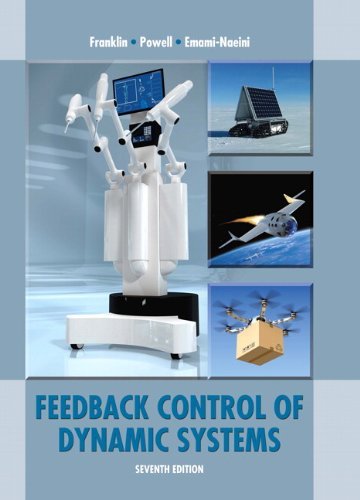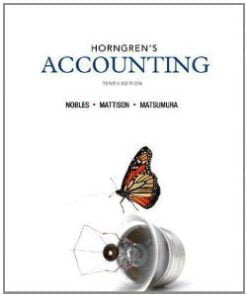Feedback Control of Dynamic Systems Franklin 7th Edition Solutions Manual
$35.00 Original price was: $35.00.$26.50Current price is: $26.50.
Feedback Control of Dynamic Systems Franklin 7th Edition Solutions Manual
Instant download Feedback Control of Dynamic Systems Franklin 7th Edition Solutions Manual pdf docx epub after payment.

Product details:
- ISBN-10 : 0133496597
- ISBN-13 : 978-0133496598
- Author: Gene F. Franklin; J. David Powell; Abbas Emami-Naeini
Feedback Control of Dynamic Systems covers the material that every engineer, and most scientists and prospective managers, needs to know about feedback control–including concepts like stability, tracking, and robustness. Each chapter presents the fundamentals along with comprehensive, worked-out examples, all within a real-world context and with historical background information. The authors also provide case studies with close integration of MATLAB throughout.
Table of contents:
1. An Overview and Brief History of Feedback Control
Chapter Overview
A Perspective on Feedback Control
1.1. A Simple Feedback System
1.2. A First Analysis of Feedback
1.3. A Brief History
1.4. An Overview of the Book
Summary
Review Questions
Problems
2. Dynamic Models
Chapter Overview
A Perspective on Dynamic Models
2.1. Dynamics of Mechanical Systems
2.2. Differential Equations in State-Variable Form
2.3. Models of Electric Circuits
2.4. Models of Electromechanical Systems
2.5. Heat- and Fluid-Flow Models
2.6. Linearization and Scaling
Summary
Review Questions
Problems
3. Dynamic Response
Chapter Overview
A Perspective on System Response
3.1. Review of Laplace Transforms
3.2. System Modeling Diagrams
3.3. Effect of Pole Locations
3.4. Time-Domain Specifications
3.5. Effects of Zeros and Additional Poles
3.6. Stability
3.7. Numerical Simulation
3.8. Obtaining Models from Experimental Data
Summary
Review Questions
Problems
4. Basic Properties of Feedback
Chapter Overview
A Perspective on Properties of Feedback
4.1. A Case Study of Speed Control
4.2. The Classical Three-Term Controller
4.3. Steady-State Tracking and System Type
4.4. Digital Implementation of Controllers
Summary
Review Questions
Problems
5. The Root-Locus Design Method
Chapter Overview
A Perspective on the Root-locus Design Method
5.1. Root Locus of a Basic Feedback System
5.2. Guidelines for Sketching a Root Locus
5.3. Selected Illustrative Root Loci
5.4. Selecting the Parameter Value
5.5. Dynamic Compensation
5.6. A Design Example Using the Root Locus
5.7. Extensions of the Root-Locus Method
Summary
Review Questions
Problems
6. The Frequency-Response Design Method
Chapter Overview
A Perspective on the Frequency-response Design Method
6.1. Frequency Response
6.2. Neutral Stability
6.3. The Nyquist Stability Criterion
6.4. Stability Margins
6.5. Bode’s Gain-Phase Relationship
6.6. Closed-Loop Frequency Response
6.7. Compensation
6.8. Alternate Presentations of Data
6.9. Specifications in Terms of the Sensitivity Function
6.10. Time Delay
6.11. Obtaining a Pole-Zero Model from Frequency-Response Data
Summary
Review Questions
Problems
7. State-Space Design
Chapter Overview
A Perspective on State-Space Design
7.1. Advantages of State Space
7.2. Analysis of the State Equations
7.3. Control-Law Design for Full-State Feedback
7.4. Selection of Pole Locations for Good Design
7.5. Estimator Design
7.6. Compensator Design: Combined Control Law and Estimator
7.7. Loop Transfer Recovery (LTR)
7.8. Introduction of the Reference Input with the Estimator
7.9. Integral Control and Robust Tracking
7.10. Direct Design with Rational Transfer Functions
7.11. Design for Systems with Pure Time Delay
7.12. Lyapunov Stability
Summary
Review Questions
Problems
8. Digital Control
Chapter Overview
A Perspective on Digital Control
8.1. Digitization
8.2. Dynamic Analysis of Discrete Systems
8.3. Design by Emulation
8.4. Discrete Design
8.5. State-Space Design Methods
8.6. Hardware Characteristics
8.7. Word-Size Effects
8.8. Sample-Rate Selection
Summary
Review Questions
Problems
9. Control-System Design: Principles and Case Studies
Chapter Overview
A Perspective on Design Principles
9.1. An Outline of Control Systems Design
9.2. Design of a Satellite’s Attitude Control
9.3. Lateral and Longitudinal Control of a Boeing 747
9.4. Control of the Fuel-Air Ratio in an Automotive Engine
9.5. Control of a Digital Tape Transport
9.6. Control of the Read/Write Head Assembly of a Hard Disk
9.7. Control of Rapid Thermal Processing (RTP) Systems in Semiconductor Wafer Manufacturing
Summary
Review Questions
Problems
Appendix A. Laplace Transforms
A.1. The L_ Laplace Transform
Appendix B. A Review of Complex Variables
B.1. Definition of a Complex Number
B.2. Algebraic Manipulations
B.3. Graphical Evaluation of Magnitude and Phase
B.4. Differentiation and Integration
B.5. Euler’s Relations
B.6. Analytic Functions
B.7. Cauchy’s Theorem
B.8. Singularities and Residues
B.9. Residue Theorem
B.10. The Argument Principle
Appendix C. Summary of Matrix Theory
C.1. Matrix Definitions
C.2. Elementary Operations on Matrices
C.3. Trace
C.4. Transpose
C.5. Determinant and Matrix Inverse
C.6. Properties of the Determinant
C.7. Inverse of Block Triangular Matrices
C.8. Special Matrices
C.9. Rank
C.10. Characteristic Polynomial
C.11. Cayley-Hamilton Theorem
C.12. Eigenvalues and Eigenvectors
C.13. Similarity Transformations
C.14. Matrix Exponential
C.15. Fundamental Subspaces
C.16. Singular-Value Decomposition
C.17. Positive Definite Matrices
C.18. Matrix Identity
Appendix D. Controllability and Observability
D.1. Controllability
D.2. Observability
Appendix E. Ackermann’s Formula for Pole Placement
Appendix F. Matlab Commands
Appendix G. Solutions to Review Questions
References
Index
People also search:
|
abrams’ clinical drug therapy rationales for nursing practice
|
clinical drug therapy rationales for nursing practice
clinical drug therapy: rationales for nursing practice
clinical drug therapy
clinical drug therapy: rationales for nursing practice answer key
Related products
Solution Manual
International Business Competing in the Global Marketplace Hill 10th Edition Solutions Manual
Solution Manual
Solution Manual for Introduction to Robotics Mechanics and Control 3rd Edition by Craig
Solution Manual
Solution Manual
Understanding Business Nickels 10th Edition Solutions Manual
Solution Manual
Solution Manual











